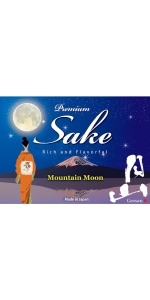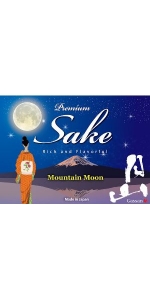Wine from Yoshida Brewing Company
The Award Winning Sake Brewery
Gassan, also known as Yoshida Sake Brewing Co., Ltd., is located in the small village of Yasugi. Yasugi is in the very Southernmost Japanese Prefecture of Shimane. The Kura or brewery was founded in 1743 and present owner Tomonori Yoshida-san's family took over the property in 1826; hence Yoshida-san is the 5th generation of family involvement and ownership with the Kura.
Over 200 years ago around Yasugi, the Amago-clan was reigning over the Sanin district. There, the clan established a castle where the feudal lord of Amago resided in the Age of Civil Wars. "GASSAN", took its premium sake brand name from the mountain in this area. Their time-honored tradition of sake brewing was established by special permission from the feudal lord of the House of Hirose. They have proudly maintained this tradition, handing down brewing secrets from generation to generation for over 180 years.
Their sake has received the gold award over ten times at the "Zenkoku Shinsyu Kanpyou Kai" (National New-Brewed Sake Contest), the foremost and authoritative contest in the Sake industry.
Gassan produces Tobin Sake or competition sakes from 18-liter tobins. The Tobin sake is very limited in production, but is marketed.
About their Fine Sake
Production is small at 700 Koku (or 14,000 9-liter cases in wine terms). Seven sake types are produced here by the ageless Master Toji, Tanaka-san, who is 84 years young. At artisanal breweries like Gassan water is all important and sure enough all of the water is sourced from mountain springs around Yasugi.
Typical of Western Style Sakes, their Nihon-Shu is big boned, rich and round, and balanced with lactic acid.
Why they got so many awards?
To make quality sake, it really depends on (1) Water, (2) Sake Rice, (3) Toji's Skill.
1. The Water Source:
Their sake is brewed with fine and super soft water, which the lord of the House of Hirose used in their tea ceremonies at the end of Edo period. (late 1800s)
The water Gassan uses for their sake is recognized as one of the best 100 waters in Japan. It was also known as one of the highest quality water in the "Fumai-style tea ceremony". Furthermore, as water varies according to climate conditions, we specially blend in other water sources to precisely control water hardness to maintain our exacting brewing requirements.
2. The Sake Rice:
Gassan does not hesitate to use high quality rice even though it may cost them. They focus on making outstanding sake for sake lovers. The sake mai or rice types used are:
- Yamada Nishiki
- Gohyakumangoku
- Sakanishiki
- Kairyoomachi
- Kannumai
3. The Master Toji's skills are superior to others:
The Master Toji Tanaka-san, is certified as "Modern master craftsman" by Ministry of Health, Labor and Welfare. The highly skilled people (a wide variety of things such as an entertainment, food, Metalwork, machine appliance assembling, repair, the sewing of clothes, carpenter) can be certified as "modern master craftsman " that Japanese government wants Masters to pass the technique to the younger generation.
Tanaka-san is also passing all of his skills to younger toji, Adachi-san. The uniqueness of Gassan is the mixture of Classic and Modern Toji skills that effect the flavor in the end.
This is the certificate of "Seishu Senmon Hyoukasha" (Sake Expert Assessor) that Tomonori Yoshida-san holds. There are about only 50 people who are certified. Out of all the 50, Yoshida-san is the Second person of the beginning. This certificate is presented by Alcoholic beverage research institute, the best liquor research organization in Japan. Whoever certified as Sake Expert Assessor, they can be called top taster, just like Master Sommelier in Wine world. Because the exams are so difficult, there are still only about 50 people certified.
Currently, there are about 1300 Kura exist in Japan, but most Kurabito (brewery people) do not hold such certificate. You need not only knowledge of sake, but also tasting skills to be certified. The producer, Yoshida-san is giving a 100% effort to create high quality sake.
Above all results, Gassan's sake is world-class sake
Gassan's sake is very easy and smooth to drink. Their constant pursuit of perfection has led to success at a national level. Now this high quality sake is available in the US.
Woodsy honeycomb, nutshell, and mushroom patch aromas with a satiny fruity-yet-dry medium-to-full body and a delicate savory mushroom stock, chestnut, and golden beet driven finish. A fine choice for tempura. 91 Points -Beverage Tasting Institute
RATING: 91 points (Exceptional)
CATEGORY: Junmai Ginjo Sake, Sake
ALCOHOL BY VOLUME: 15.4%
TASTING LOCATION: In Our Chicago Tasting Room
TASTING DATE: Dec-05-2012
WINE ID: 200767
Woodsy honeycomb, nutshell, and mushroom patch aromas with a satiny fruity-yet-dry medium-to-full body and a delicate savory mushroom stock, chestnut, and golden beet driven finish. A fine choice for tempura. 91 Points -Beverage Tasting Institute
RATING: 91 points (Exceptional)
CATEGORY: Junmai Ginjo Sake, Sake
ALCOHOL BY VOLUME: 15.4%
TASTING LOCATION: In Our Chicago Tasting Room
TASTING DATE: Dec-05-2012
WINE ID: 200767
- back
Selected Options
Wineries
Categories
Pricing
Countries
Regions
Grape Types
Wineries
Organic/Free Shipping
SOLD BY THE BOX, NOT BY THE BOTTLE
IF YOU WOULD LIKE THE WOODEN BOX WE CHARGE A FLAT SHIPPING FEE OF 15 TO SHIP IT. JUST LET US KNOW ON THE COMMENT SECTION OF THE CHECKOUT PAGE.
The “Vintners Collection” gift boxes includes all six of Long Shadows’ acclaimed red wines packaged together in a beautifully branded wood box. Each of these wines were inspired and crafted by a world-renowned vintner to showcase the viticultural quality and caliber of Washington state’s Columbia Valley:
Pirouette: Philippe Melka (Vineyard 29, Lail, Hundred Acre) & Agustin Huneeus, Sr.(Quintessa)
Feather Cabernet Sauvignon: Randy Dunn (Dunn Vineyards)
Pedestal Merlot: Michel Rolland (International Wine Consultant)
Chester-Kidder: Allen Shoup (Chateau Ste. Michelle, CEO) & Gilles Nicault (Woodward Canyon)
Sequel Syrah: John Duval (Penfolds Grange, Plexus, Entity)
Saggi: Ambrogio & Giovanni Folonari (A & G Folonari Tenute, Tuscany)
Average age of the vines: 30 years old (between 20 and 60 years old). Skin contact maceration: between 2 and 5 days depending on the parcels.
Beaujolais-Nouveau has been very popular with almost every Thanksgiving dish - from turkey to ham, green beans to mashed potatoes, and gravy to cranberry sauce.
The Beaujolais Villages Nouveau is deeper red, with flavors reminiscent of strawberries and roses, plus a mineral component. Fragrant and medium bodied; refreshing with a tart finish. Beaujolais Villages Nouveau is meant to be consumed young, within 5-7 months.
Beaujolais Nouveau originated about a century ago as a 'vin de l'année' - a cheap and cheerful drink produced by locals to celebrate the end of the harvest season. The Beaujolais AOC was established in 1937, and after WWII, the wine was sold outside of the area. By the 1970's, Beaujolais Nouveau day was a national event.
he region of Beaujolais is 34 miles long from north to south, and 7 to 9 miles wide. There are nearly 4,000 grape growers who make their living in this picturesque region just north of France's third largest city, Lyon.
The Gamay grapes that go into Beaujolais Nouveau are handpicked, as are all the grapes in the Beaujolais. Beaujolais & Champagne are the only vineyards where hand harvesting is mandatory. Gamay (Gamay noir Jus Blanc) is the only grape permitted for Beaujolais.
Beaujolais Nouveau cannot be made from grapes grown in the 10 crus (great growths) of Beaujolais; only from grapes coming from the appellations of Beaujolais and Beaujolais-Villages. Approximately 1/3 of the entire crop of the Beaujolais region is sold as Beaujolais Nouveau.
Nouveau is made with carbonic maceration, or whole-berry fermentation. This technique preserves the fresh, fruity quality of the grapes without extracting bitter tannins from the grape skins.






